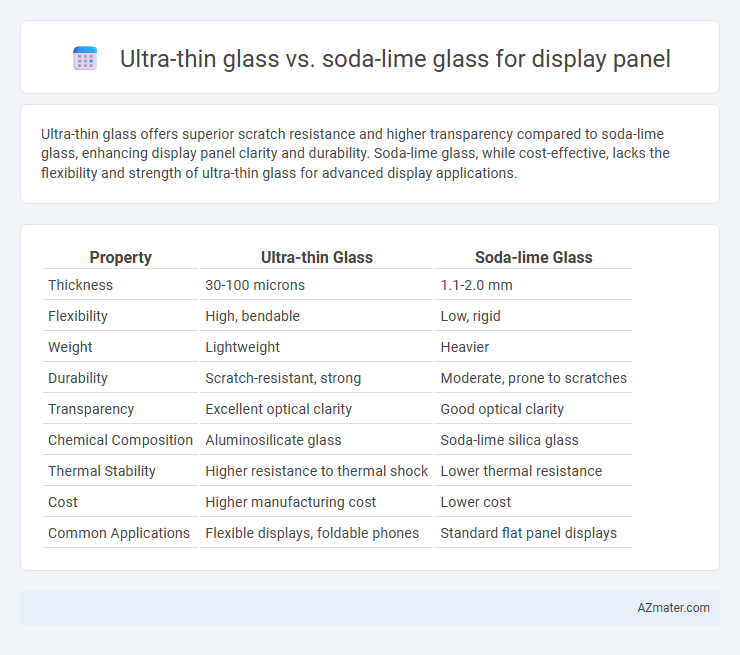Ultra-thin glass offers superior scratch resistance and higher transparency compared to soda-lime glass, enhancing display panel clarity and durability. Soda-lime glass, while cost-effective, lacks the flexibility and strength of ultra-thin glass for advanced display applications.
Table of Comparison
| Property | Ultra-thin Glass | Soda-lime Glass |
|---|---|---|
| Thickness | 30-100 microns | 1.1-2.0 mm |
| Flexibility | High, bendable | Low, rigid |
| Weight | Lightweight | Heavier |
| Durability | Scratch-resistant, strong | Moderate, prone to scratches |
| Transparency | Excellent optical clarity | Good optical clarity |
| Chemical Composition | Aluminosilicate glass | Soda-lime silica glass |
| Thermal Stability | Higher resistance to thermal shock | Lower thermal resistance |
| Cost | Higher manufacturing cost | Lower cost |
| Common Applications | Flexible displays, foldable phones | Standard flat panel displays |
Introduction to Display Panel Glass Materials
Ultra-thin glass offers superior mechanical strength, flexibility, and high optical clarity compared to traditional soda-lime glass, making it ideal for cutting-edge display panels. Soda-lime glass, widely used due to its low cost and ease of manufacturing, lacks the durability and thinness required for flexible or foldable displays. Advanced display technologies increasingly favor ultra-thin glass to achieve lightweight, high-resolution screens with enhanced touch sensitivity and improved resistance to scratches and impacts.
What is Ultra-thin Glass?
Ultra-thin glass (UTG) is a highly flexible, lightweight glass with a thickness typically under 100 micrometers, designed specifically for advanced display panels such as foldable smartphones and flexible OLED screens. In contrast to traditional soda-lime glass, UTG offers superior durability, enhanced scratch resistance, and significantly improved bendability without compromising optical clarity or touch sensitivity. The technological innovation behind UTG allows manufacturers to create more compact, resilient, and curved display designs, pushing the boundaries of modern consumer electronics.
Understanding Soda-lime Glass
Soda-lime glass, a widely used material in display panels, offers cost-effectiveness and ease of manufacturing but lacks the ultra-thin flexibility and high durability found in ultra-thin glass (UTG). Its higher thickness and lower strength limit the design possibilities for modern foldable and curved displays, where UTG excels due to enhanced bendability and resistance to scratches. Understanding the fundamental chemical composition of soda-lime glass, primarily silica, sodium oxide, and calcium oxide, explains its rigidity and susceptibility to breakage compared to the chemically strengthened surface of ultra-thin glass.
Key Differences: Composition and Structure
Ultra-thin glass used in display panels primarily consists of alumino-silicate or borosilicate compositions, offering a highly uniform and ultra-smooth surface with enhanced flexibility and strength. Soda-lime glass, the most common glass type, is composed mainly of silica, soda, and lime, resulting in a thicker, less flexible structure with lower mechanical strength. The tailored composition and laminar structure of ultra-thin glass enable superior scratch resistance, thermal stability, and minimal light distortion compared to conventional soda-lime glass.
Optical Clarity and Light Transmission
Ultra-thin glass offers superior optical clarity compared to soda-lime glass, with higher light transmission rates typically exceeding 90%, making it ideal for high-resolution display panels. Soda-lime glass, though cost-effective, generally has lower light transmission and can introduce slight color distortion due to its inherent impurities. Enhanced purity and uniform thickness in ultra-thin glass minimize light scattering and reflection, optimizing visual performance in advanced electronic displays.
Mechanical Strength and Durability
Ultra-thin glass offers superior mechanical strength compared to soda-lime glass, with thickness typically ranging from 0.1 to 0.4 mm, enhancing its resistance to bending and shattering in display panels. Soda-lime glass, while cost-effective, exhibits lower fracture toughness and is more prone to surface damage under impact or repeated flexing. The durability of ultra-thin glass makes it ideal for flexible and foldable displays, providing enhanced longevity and maintaining optical clarity under mechanical stress.
Flexibility and Thickness Options
Ultra-thin glass offers superior flexibility compared to traditional soda-lime glass, enabling curved and foldable display panels with thicknesses as low as 0.03 mm. Soda-lime glass typically starts at thicknesses around 0.4 mm, limiting its use in flexible display technologies due to its rigidity. The reduced thickness and enhanced bendability of ultra-thin glass make it ideal for next-generation OLED and AMOLED screens requiring durable yet pliable substrates.
Cost Comparison and Manufacturing Challenges
Ultra-thin glass offers superior durability and flexibility compared to soda-lime glass but comes with significantly higher production costs due to advanced manufacturing processes like laser cutting and tempering. Soda-lime glass remains cost-effective for large-scale production with simpler processing techniques but struggles to meet the performance demands of modern flexible and high-resolution display panels. Manufacturing challenges for ultra-thin glass include minimizing breakage during handling and ensuring consistent thickness below 100 microns, while soda-lime glass faces limitations in achieving ultra-thin profiles without compromising structural integrity.
Applications in Modern Display Panels
Ultra-thin glass offers superior flexibility, high optical clarity, and exceptional strength, making it ideal for foldable smartphones, wearable devices, and advanced OLED displays. Soda-lime glass, commonly used in traditional LCD panels, provides cost-effective durability and ease of manufacture but lacks the flexibility required for curved or bendable screens. Modern display panels prioritize ultra-thin glass to enable innovative form factors while maintaining high resolution and durability in flexible and transparent applications.
Future Trends: Innovations in Display Glass
Ultra-thin glass offers significant advancements over traditional soda-lime glass by enabling flexible, foldable, and rollable displays due to its exceptional thinness and durability. Innovations in display glass technology emphasize enhanced scratch resistance, improved transparency, and lower weight, driving future trends toward more immersive and lightweight devices. The integration of ultra-thin glass with emerging OLED and micro-LED panels supports the evolution of next-generation smartphones, wearable devices, and rollable televisions.

Infographic: Ultra-thin glass vs Soda-lime glass for Display panel
 azmater.com
azmater.com